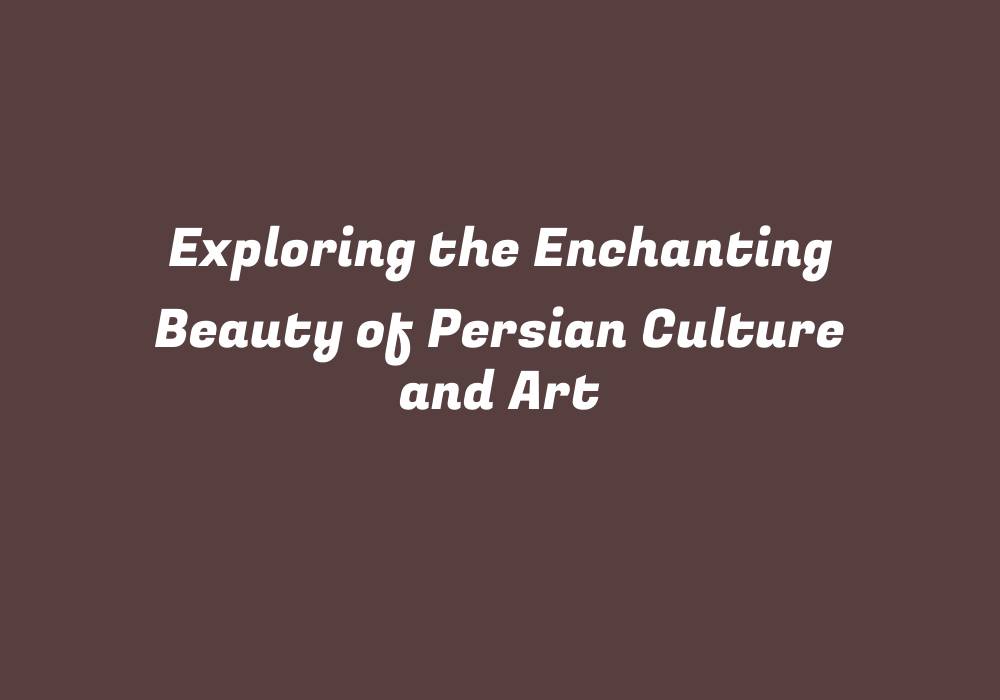Introduction to Persian Culture and Art
Persian culture and art have fascinated the world for centuries, enchanting those who encounter its captivating blend of history, religion, philosophy, literature, music, and visual arts. This diverse, rich cultural tapestry has been a source of inspiration for many artists worldwide, leaving an indelible mark on their work and shaping our understanding of artistic expression.
In this article, we will delve into the essence of Persian culture and art, exploring its roots in ancient Iran, the development of Persian poetry and literature, the distinct elements of Persian music, and the intricate, mesmerizing world of Persian miniature painting. We will also discuss how these various aspects contribute to the profound impact of Persian culture on the world’s artistic landscape.
Ancient Roots in Iran
The origins of Persian culture are deeply rooted in ancient Iran. This region has a long and rich history that predates the Achaemenid Empire, the first great Persian empire. The influence of its diverse cultural elements can be traced through various historical periods, including the Medes, Parthians, and Sassanids.
The Achaemenid Empire, founded by Cyrus the Great in 550 BCE, became one of the largest empires in ancient history, stretching across three continents. This period marked a significant shift in art and culture as it united diverse peoples, religions, and philosophies under a shared identity.
Persian Poetry and Literature: The Timeless Language of Love and Wisdom
Persian poetry and literature have been an integral part of Persian culture for thousands of years. Famous literary works such as the Shahnameh (The Book of Kings) by Ferdowsi, a national epic that tells tales from Iran’s rich historical past, are still widely read and studied today. This timeless work has captured the hearts of countless generations of readers and is considered one of the most influential literary achievements in world literature.
Other notable Persian poets include Hafiz (1325-1390), a master of mystical poetry, Rumi (1207-1273), who wrote some of the most beautiful love poems in history, and Sa’adi (1211-1291), a Sufi poet known for his wisdom and humanitarian outlook. The works of these poets have transcended time, continuing to resonate with modern readers through their profound insights into love, loss, and the human experience.
Persian Music: The Harmony of Melody and Rhythm
Music has always played a vital role in Persian culture. It is an integral part of everyday life, used for celebrations, religious ceremonies, and daily rituals. Persian music combines various elements, such as vocal and instrumental performance, percussion, and improvisation, to create a unique musical language.
Traditional Persian musical instruments include the tar, a long-necked lute with a pear-shaped body; the setar, an ancient 3-stringed instrument similar in appearance to the tar; and the tonbak, a goblet drum used for rhythmic accompaniment.
The most notable aspect of Persian music is the distinct mode system called Dastgah. This complex structure combines melody, harmony, and rhythm, creating an intricate musical landscape that has greatly influenced classical music in India and Central Asia. Today, this musical tradition continues to evolve with new generations of musicians, embracing a blend of traditional elements and contemporary influences.
Persian Miniature Painting: The Visual Poetry of Love and Beauty
One of the most captivating aspects of Persian culture is its rich tradition of miniature painting. Developed over centuries, this unique art form reached its peak during the Safavid period (1502-1736), with artists like Reza Abbasi and Kamal ol-Molk producing some of the finest works in the genre.
Persian miniatures are characterized by their delicate lines, vibrant colors, and intricate detailing. These paintings often depict scenes from literature, religious themes, or portraits of famous individuals, creating a visual narrative that captivates the viewer with its beauty and symbolism. The artists’ skill in rendering both human emotion and landscapes has earned them international acclaim and continues to influence modern-day art.
Conclusion: A Timeless Legacy of Art and Culture
The diverse elements of Persian culture and art have contributed significantly to the world’s artistic landscape, influencing numerous artists, writers, and musicians across time and space. Through their rich history, unique musical traditions, and mesmerizing miniature paintings, they remind us that a shared appreciation for beauty and human experience transcends borders and centuries.
In conclusion, the enchanting beauty of Persian culture and art lies in its timeless blend of poetry, literature, music, and visual arts, which together create an enduring legacy that continues to inspire and captivate those who encounter it.
